Yunming Ye
Towards Improved Text-Aligned Codebook Learning: Multi-Hierarchical Codebook-Text Alignment with Long Text
Mar 03, 2025Abstract:Image quantization is a crucial technique in image generation, aimed at learning a codebook that encodes an image into a discrete token sequence. Recent advancements have seen researchers exploring learning multi-modal codebook (i.e., text-aligned codebook) by utilizing image caption semantics, aiming to enhance codebook performance in cross-modal tasks. However, existing image-text paired datasets exhibit a notable flaw in that the text descriptions tend to be overly concise, failing to adequately describe the images and provide sufficient semantic knowledge, resulting in limited alignment of text and codebook at a fine-grained level. In this paper, we propose a novel Text-Augmented Codebook Learning framework, named TA-VQ, which generates longer text for each image using the visual-language model for improved text-aligned codebook learning. However, the long text presents two key challenges: how to encode text and how to align codebook and text. To tackle two challenges, we propose to split the long text into multiple granularities for encoding, i.e., word, phrase, and sentence, so that the long text can be fully encoded without losing any key semantic knowledge. Following this, a hierarchical encoder and novel sampling-based alignment strategy are designed to achieve fine-grained codebook-text alignment. Additionally, our method can be seamlessly integrated into existing VQ models. Extensive experiments in reconstruction and various downstream tasks demonstrate its effectiveness compared to previous state-of-the-art approaches.
AsyncDSB: Schedule-Asynchronous Diffusion Schrödinger Bridge for Image Inpainting
Dec 11, 2024

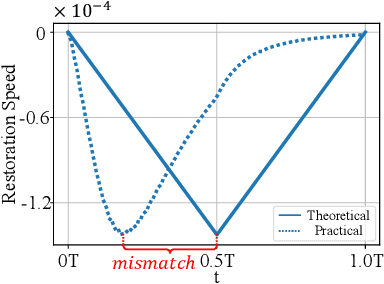
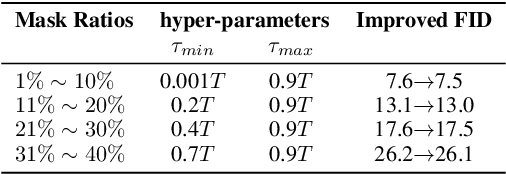
Abstract:Image inpainting is an important image generation task, which aims to restore corrupted image from partial visible area. Recently, diffusion Schr\"odinger bridge methods effectively tackle this task by modeling the translation between corrupted and target images as a diffusion Schr\"odinger bridge process along a noising schedule path. Although these methods have shown superior performance, in this paper, we find that 1) existing methods suffer from a schedule-restoration mismatching issue, i.e., the theoretical schedule and practical restoration processes usually exist a large discrepancy, which theoretically results in the schedule not fully leveraged for restoring images; and 2) the key reason causing such issue is that the restoration process of all pixels are actually asynchronous but existing methods set a synchronous noise schedule to them, i.e., all pixels shares the same noise schedule. To this end, we propose a schedule-Asynchronous Diffusion Schr\"odinger Bridge (AsyncDSB) for image inpainting. Our insight is preferentially scheduling pixels with high frequency (i.e., large gradients) and then low frequency (i.e., small gradients). Based on this insight, given a corrupted image, we first train a network to predict its gradient map in corrupted area. Then, we regard the predicted image gradient as prior and design a simple yet effective pixel-asynchronous noise schedule strategy to enhance the diffusion Schr\"odinger bridge. Thanks to the asynchronous schedule at pixels, the temporal interdependence of restoration process between pixels can be fully characterized for high-quality image inpainting. Experiments on real-world datasets show that our AsyncDSB achieves superior performance, especially on FID with around 3% - 14% improvement over state-of-the-art baseline methods.
Prototype Optimization with Neural ODE for Few-Shot Learning
Nov 19, 2024Abstract:Few-Shot Learning (FSL) is a challenging task, which aims to recognize novel classes with few examples. Pre-training based methods effectively tackle the problem by pre-training a feature extractor and then performing class prediction via a cosine classifier with mean-based prototypes. Nevertheless, due to the data scarcity, the mean-based prototypes are usually biased. In this paper, we attempt to diminish the prototype bias by regarding it as a prototype optimization problem. To this end, we propose a novel prototype optimization framework to rectify prototypes, i.e., introducing a meta-optimizer to optimize prototypes. Although the existing meta-optimizers can also be adapted to our framework, they all overlook a crucial gradient bias issue, i.e., the mean-based gradient estimation is also biased on sparse data. To address this issue, in this paper, we regard the gradient and its flow as meta-knowledge and then propose a novel Neural Ordinary Differential Equation (ODE)-based meta-optimizer to optimize prototypes, called MetaNODE. Although MetaNODE has shown superior performance, it suffers from a huge computational burden. To further improve its computation efficiency, we conduct a detailed analysis on MetaNODE and then design an effective and efficient MetaNODE extension version (called E2MetaNODE). It consists of two novel modules: E2GradNet and E2Solver, which aim to estimate accurate gradient flows and solve optimal prototypes in an effective and efficient manner, respectively. Extensive experiments show that 1) our methods achieve superior performance over previous FSL methods and 2) our E2MetaNODE significantly improves computation efficiency meanwhile without performance degradation.
LG-VQ: Language-Guided Codebook Learning
May 23, 2024Abstract:Vector quantization (VQ) is a key technique in high-resolution and high-fidelity image synthesis, which aims to learn a codebook to encode an image with a sequence of discrete codes and then generate an image in an auto-regression manner. Although existing methods have shown superior performance, most methods prefer to learn a single-modal codebook (\emph{e.g.}, image), resulting in suboptimal performance when the codebook is applied to multi-modal downstream tasks (\emph{e.g.}, text-to-image, image captioning) due to the existence of modal gaps. In this paper, we propose a novel language-guided codebook learning framework, called LG-VQ, which aims to learn a codebook that can be aligned with the text to improve the performance of multi-modal downstream tasks. Specifically, we first introduce pre-trained text semantics as prior knowledge, then design two novel alignment modules (\emph{i.e.}, Semantic Alignment Module, and Relationship Alignment Module) to transfer such prior knowledge into codes for achieving codebook text alignment. In particular, our LG-VQ method is model-agnostic, which can be easily integrated into existing VQ models. Experimental results show that our method achieves superior performance on reconstruction and various multi-modal downstream tasks.
MCSDNet: Mesoscale Convective System Detection Network via Multi-scale Spatiotemporal Information
Apr 26, 2024



Abstract:The accurate detection of Mesoscale Convective Systems (MCS) is crucial for meteorological monitoring due to their potential to cause significant destruction through severe weather phenomena such as hail, thunderstorms, and heavy rainfall. However, the existing methods for MCS detection mostly targets on single-frame detection, which just considers the static characteristics and ignores the temporal evolution in the life cycle of MCS. In this paper, we propose a novel encoder-decoder neural network for MCS detection(MCSDNet). MCSDNet has a simple architecture and is easy to expand. Different from the previous models, MCSDNet targets on multi-frames detection and leverages multi-scale spatiotemporal information for the detection of MCS regions in remote sensing imagery(RSI). As far as we know, it is the first work to utilize multi-scale spatiotemporal information to detect MCS regions. Firstly, we design a multi-scale spatiotemporal information module to extract multi-level semantic from different encoder levels, which makes our models can extract more detail spatiotemporal features. Secondly, a Spatiotemporal Mix Unit(STMU) is introduced to MCSDNet to capture both intra-frame features and inter-frame correlations, which is a scalable module and can be replaced by other spatiotemporal module, e.g., CNN, RNN, Transformer and our proposed Dual Spatiotemporal Attention(DSTA). This means that the future works about spatiotemporal modules can be easily integrated to our model. Finally, we present MCSRSI, the first publicly available dataset for multi-frames MCS detection based on visible channel images from the FY-4A satellite. We also conduct several experiments on MCSRSI and find that our proposed MCSDNet achieve the best performance on MCS detection task when comparing to other baseline methods.
Four-hour thunderstorm nowcasting using deep diffusion models of satellite
Apr 16, 2024



Abstract:Convection (thunderstorm) develops rapidly within hours and is highly destructive, posing a significant challenge for nowcasting and resulting in substantial losses to nature and society. After the emergence of artificial intelligence (AI)-based methods, convection nowcasting has experienced rapid advancements, with its performance surpassing that of physics-based numerical weather prediction and other conventional approaches. However, the lead time and coverage of it still leave much to be desired and hardly meet the needs of disaster emergency response. Here, we propose a deep diffusion model of satellite (DDMS) to establish an AI-based convection nowcasting system. On one hand, it employs diffusion processes to effectively simulate complicated spatiotemporal evolution patterns of convective clouds, significantly improving the forecast lead time. On the other hand, it utilizes geostationary satellite brightness temperature data, thereby achieving planetary-scale forecast coverage. During long-term tests and objective validation based on the FengYun-4A satellite, our system achieves, for the first time, effective convection nowcasting up to 4 hours, with broad coverage (about 20,000,000 km2), remarkable accuracy, and high resolution (15 minutes; 4 km). Its performance reaches a new height in convection nowcasting compared to the existing models. In terms of application, our system operates efficiently (forecasting 4 hours of convection in 8 minutes), and is highly transferable with the potential to collaborate with multiple satellites for global convection nowcasting. Furthermore, our results highlight the remarkable capabilities of diffusion models in convective clouds forecasting, as well as the significant value of geostationary satellite data when empowered by AI technologies.
Codebook Transfer with Part-of-Speech for Vector-Quantized Image Modeling
Mar 15, 2024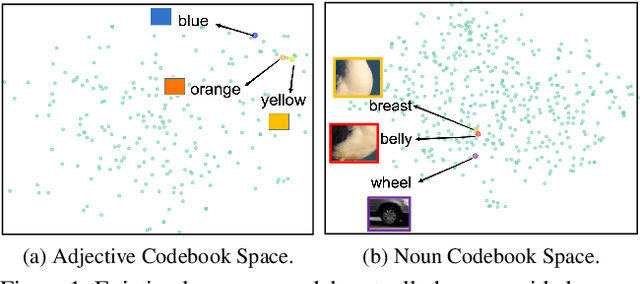

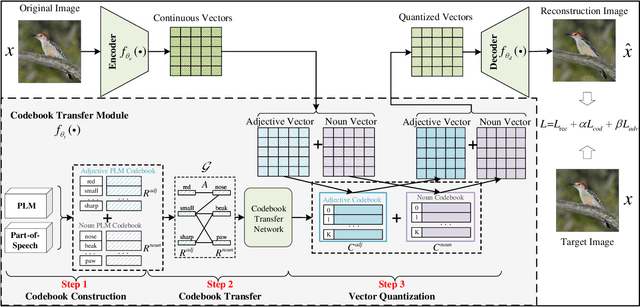

Abstract:Vector-Quantized Image Modeling (VQIM) is a fundamental research problem in image synthesis, which aims to represent an image with a discrete token sequence. Existing studies effectively address this problem by learning a discrete codebook from scratch and in a code-independent manner to quantize continuous representations into discrete tokens. However, learning a codebook from scratch and in a code-independent manner is highly challenging, which may be a key reason causing codebook collapse, i.e., some code vectors can rarely be optimized without regard to the relationship between codes and good codebook priors such that die off finally. In this paper, inspired by pretrained language models, we find that these language models have actually pretrained a superior codebook via a large number of text corpus, but such information is rarely exploited in VQIM. To this end, we propose a novel codebook transfer framework with part-of-speech, called VQCT, which aims to transfer a well-trained codebook from pretrained language models to VQIM for robust codebook learning. Specifically, we first introduce a pretrained codebook from language models and part-of-speech knowledge as priors. Then, we construct a vision-related codebook with these priors for achieving codebook transfer. Finally, a novel codebook transfer network is designed to exploit abundant semantic relationships between codes contained in pretrained codebooks for robust VQIM codebook learning. Experimental results on four datasets show that our VQCT method achieves superior VQIM performance over previous state-of-the-art methods.
DiffCast: A Unified Framework via Residual Diffusion for Precipitation Nowcasting
Dec 11, 2023



Abstract:Precipitation nowcasting is an important spatio-temporal prediction task to predict the radar echoes sequences based on current observations, which can serve both meteorological science and smart city applications. Due to the chaotic evolution nature of the precipitation systems, it is a very challenging problem. Previous studies address the problem either from the perspectives of deterministic modeling or probabilistic modeling. However, their predictions suffer from the blurry, high-value echoes fading away and position inaccurate issues. The root reason of these issues is that the chaotic evolutionary precipitation systems are not appropriately modeled. Inspired by the nature of the systems, we propose to decompose and model them from the perspective of global deterministic motion and local stochastic variations with residual mechanism. A unified and flexible framework that can equip any type of spatio-temporal models is proposed based on residual diffusion, which effectively tackles the shortcomings of previous methods. Extensive experimental results on four publicly available radar datasets demonstrate the effectiveness and superiority of the proposed framework, compared to state-of-the-art techniques. Our code will be made publicly available soon.
HPCR: Holistic Proxy-based Contrastive Replay for Online Continual Learning
Sep 26, 2023Abstract:Online continual learning (OCL) aims to continuously learn new data from a single pass over the online data stream. It generally suffers from the catastrophic forgetting issue. Existing replay-based methods effectively alleviate this issue by replaying part of old data in a proxy-based or contrastive-based replay manner. In this paper, we conduct a comprehensive analysis of these two replay manners and find they can be complementary. Inspired by this finding, we propose a novel replay-based method called proxy-based contrastive replay (PCR), which replaces anchor-to-sample pairs with anchor-to-proxy pairs in the contrastive-based loss to alleviate the phenomenon of forgetting. Based on PCR, we further develop a more advanced method named holistic proxy-based contrastive replay (HPCR), which consists of three components. The contrastive component conditionally incorporates anchor-to-sample pairs to PCR, learning more fine-grained semantic information with a large training batch. The second is a temperature component that decouples the temperature coefficient into two parts based on their impacts on the gradient and sets different values for them to learn more novel knowledge. The third is a distillation component that constrains the learning process to keep more historical knowledge. Experiments on four datasets consistently demonstrate the superiority of HPCR over various state-of-the-art methods.
UER: A Heuristic Bias Addressing Approach for Online Continual Learning
Sep 08, 2023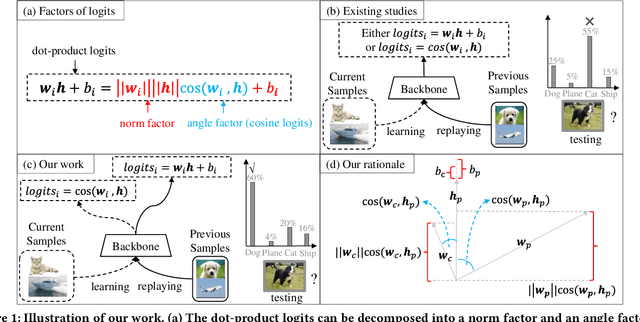
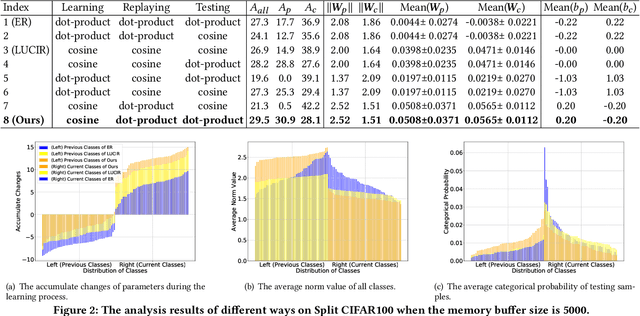
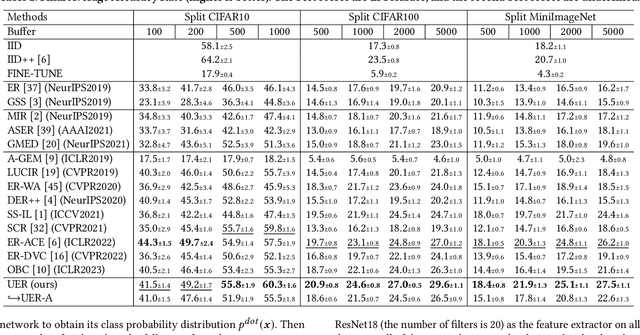

Abstract:Online continual learning aims to continuously train neural networks from a continuous data stream with a single pass-through data. As the most effective approach, the rehearsal-based methods replay part of previous data. Commonly used predictors in existing methods tend to generate biased dot-product logits that prefer to the classes of current data, which is known as a bias issue and a phenomenon of forgetting. Many approaches have been proposed to overcome the forgetting problem by correcting the bias; however, they still need to be improved in online fashion. In this paper, we try to address the bias issue by a more straightforward and more efficient method. By decomposing the dot-product logits into an angle factor and a norm factor, we empirically find that the bias problem mainly occurs in the angle factor, which can be used to learn novel knowledge as cosine logits. On the contrary, the norm factor abandoned by existing methods helps remember historical knowledge. Based on this observation, we intuitively propose to leverage the norm factor to balance the new and old knowledge for addressing the bias. To this end, we develop a heuristic approach called unbias experience replay (UER). UER learns current samples only by the angle factor and further replays previous samples by both the norm and angle factors. Extensive experiments on three datasets show that UER achieves superior performance over various state-of-the-art methods. The code is in https://github.com/FelixHuiweiLin/UER.
 Add to Chrome
Add to Chrome Add to Firefox
Add to Firefox Add to Edge
Add to Edge